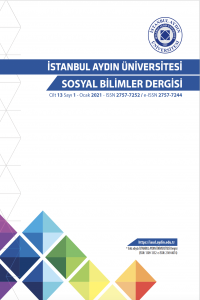EŞ KANALLI AÇISAL PRESLEME (EKAP) YÖNTEMİNİN 6063 ALÜMİNYUM ALAŞIMININ MEKANİK ÖZELLİKLERİNE ETKİSİNİN ARAŞTIRILMASI
Aşırı plastik deformasyon (APD) hem fiziksel hem de mekanik özelliklerin geliştirilmesi amacıyla malzemenin geometrik olarak şekillendirilmesidir. Geleneksel plastik şekillendirmeye alternatif eş kanallı açısal plastik şekil değiştirme (EKAP) yöntemi üstün mekanik özellikler elde etmek amacıyla kullanılmakta ve geliştirilmektedir. Parçaya tek seferde büyük birim şekil değişiminin uygulanıyor olması ve dislokasyonların yeniden düzenlenmesi sonucunda geleneksel yöntemlere kıyasla çok daha küçük tane büyüklüğünün elde edilmektedir. Malzemelerde alışılmamış bir özellik olan süneklik ve yüksek dayanım kombinasyonunu sağlayan, aşırı plastik yöntemlerinden en bilineni olan eş kanallı açısal presleme (EKAP), günümüzde uygulama alanı olarak kendine en çok yer bulma potansiyeli gösteren yöntem olarak karşımıza çıkmaktadır. Bu çalışmada, aşırı plastik deformasyon metotlarından eş kanallı açısal preslemenin (EKAP), 6063 alüminyum alaşımının mekanik özelliklerine etkisi incelenmiştir.
Anahtar Kelimeler:
Alüminyum alaşımı, EKAP, APD, Ultra ince tane, Mekanik özellikler
___
- [1] Gleiter, H. (2001). Nanostructured materials: Basic concepts and microstructure, Acta Materials, pp. 48-29.
- [2] Azushima, A., Kopp, R., Korhonen, A., Yang, D.Y., Micari, F., Lahoti, G.D., Groche, P.,Yanagimoto, J., Tsuji, N., Rosochowski, A., Yanagida, A. (2008). Severe plastic deformation (SPD) processes for metals, CIRP Annals - Manufacturing Technology, 57, 716–735.
- [3] Akata, H. E. (2012). Application of Separated Die Design to Production of Ecap Dies, Advanced Materials Research, Vol. 445, pp.120-124.
- [4] Beyerlein, I. J., Lebensohn, R. A., Tome, C. N. (2003). Modeling texture and microstructural evolution in the equal channel angular extrusion process, Materials Science and Engineering, 345 (1-2):122-138.
- [5] Sanusi, K. O., Makinde, O. D., Oliver, G. J. (2012). Equal channel angular pressing technique for the formation of ultra-fine grained structures, South African Journal of Science, 108(9/10)
- [6] Segal, V. M. (1995). Material Processing by simple shear, Mater. Sci. Eng., A 197, 157-164.
- [7] Valiev, R.Z., Islamgaliev, R.K,. Alexandrov, I.V. (2000). Bulk nanostructured materials from severe plastic deformation, Prog. Mater. Sci., 45:103-189.
- [8] Sahin, M., Balasubramanian, N., Misirli, C., Akata, H. E., Can, Y., Ozel, K. (2012). On properties at interfaces of friction welded near-nanostructured Al 5083 alloys, Internatıonal Journal of Advanced Manufacturıng Technology, Volume: 61, Issue: 9-12, Pages: 935-943
- [9] Valiev, R. Z., Langdon, T. G. (2006). Principles of equal-channel angular pressing as a processing tool for grain refinement, Progress in Materials Science, 51, 881–981
- [10] Thiyagarajan, R., Gopinath, A. (2014). Enhancement of Mechanical Properties of AA 6351 Using Equal Channel Angular Extrusion (ECAE), Materials Science and Metallurgy Engineering, vol. 2, no. 2: 26-30.
- [11] Konuk, O., Akata, H.E. (2013). A Study On The Application Of The Ecap To Surface Plating. International Journal Of Electronics, Mechanical And Mechatronics Engineering (IJEMME), 3(4), 625-630.
- [12] Mathieu, J. P., Suwas, S., Eberhardt, A., Toth, L. S., Moll, P., (2006). A new design for equal channel angular extrusion, Journal of Materials Processing Technology, 173 (1), page 29-33.
- [13] Furuno, K., Akamatsu, H., Oh-ishi, K., Furukawa, M., Horita, Z., Langdon, T. G. (2004). Microstructural Development İn Equal-Channel Angular Pressing Using A 60° Die, Acta Materialia, 52, 2497–2507
- [14] Veeranjaneyulu, K., Siddhartha, C. (2016). Computational Analysis of Equal Channel Angular Pressing for Aluminum Alloys, International Journal &Magazine of Engineering, Technology, Management and Research, ISSN: 2348-4845, Vol. 3, No: 8.
- [15] Werenskiold, J. C. (2004). Equal Channel Angular Pressing (ECAP) of AA6082: Mechanical Properties, Texture and Microstructural Development, Doctoral Theses, Norwegian University, Trondheim. [16] Yamashita, A., Horita, Z., Langdon, T. G., (2001). Improving the Mechanical Properties of Magnesium and a Magnesium Alloy through Severe Plastic Deformation, Materials Science and Engineering A, 300, 142–147
- [17] Colombo, G. (2010). The Effect of Equal Channel Angular Extrusion (ECAE) and Boron Additions on the Mechanical Properties of a Biomedical Ti-Nb-Zr-Ta (TNZT) Alloy, All Theses and Dissertations (ETDs), 73.
- [18] Mogucheva, A., Babich, E., Ovsyannikov, B., Kaibyshev, R. (2013). Microstructural evolution in a 5024 aluminum alloy processed by ECAP with and without back pressure, Mat. Sci. Eng., A 560, 178–192.
- [19] Chaudhury, P. K., Cherukuri, B., Srinivasan, R. (2005). Scaling up of Equal-Channel Angular Pressing and Its Effect on Mechanical Properties, Microstructure, and Hot Workability of AA 6061, Materials Science and Engineering A, 410-411, 316-318.
- [20] Komura, S., Furukawa, M., Horita, Z., Nemoto, M., Langdon, T. G. (2001). Optimizing the Procedure of Equal-Channel Angular Pressing for Maximum Superplasticity, Mater. Sci. Eng., Vol A297, p 111-118
- ISSN: 2757-7252
- Yayın Aralığı: Yılda 4 Sayı
- Başlangıç: 2009
- Yayıncı: İstanbul Aydın Üniversitesi
Sayıdaki Diğer Makaleler
SİVİL TOPLUM ÖRGÜTLERİ VE HALKLA İLİŞKİLER ÇALIŞMALARI (TEGV ÖRNEĞİ)
EŞİT KANALLI AÇISAL PRESLEME (EKAP) KALIPLARININ GELİŞTİRİLMESİ VE ALÜMİNYUM MALZEME UYGULANMASI
Ö.faruk KAHRİMAN, H. Erol AKATA
AKILLI EV SİSTEMLERİNDE KULLANILAN YÖNTEMLERİN FARKLARI, AVANTAJLARI VE DEZAVANTAJLARI
KRİZ YÖNETİMİ AÇISINDAN GELENEKSEL VE SOSYAL MEDYA
2016 AMERİKAN SEÇİMLERİ ÜZERİNDEN SİSTEM ELEŞTİRİSİ KÜLTÜRÜ
HAVAYOLU ŞİRKETLERİNİN KRİZ DÖNEMİNDE UYGULAMASI BEKLENEN STRATEJİLERİ
Şehmuz DEVELİOĞLU, H. Erol AKATA
ULAŞTIRMA ALTYAPI YATIRIMLARININ FİNANSAL AÇIDAN DEĞERLENDİRİLMESİ
Emine KARAMAN, Mehmet Fatih ALTAN
